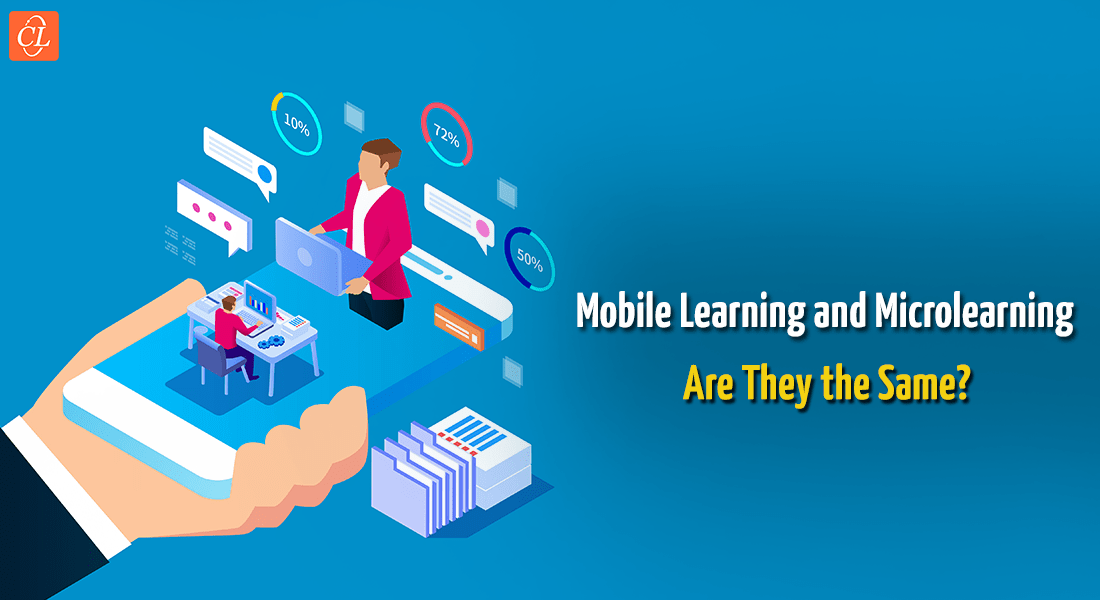How Microlearning and Mobile Learning Can be the Best Duo for Corporate Training

The world of eLearning is constantly evolving to reach newer heights. There is always a new and more engaging way to grasp otherwise complicated concepts, empowered by technology and innovation. As a result, every few years, a new trend or technology emerges that changes the way we learn and consume information. Lately, two of the hottest topics in eLearning are microlearning and mobile learning.
Here Are a Few Benefits of Microlearning and Mobile Learning
Microlearning
- Can be completed in short, bite-sized sessions that fit into busy schedules
- Helps learners retain information more effectively
- Is versatile and can be used for a variety of different content types
- Can be easily integrated into existing eLearning courses
Mobile Learning
- Is much more convenient and can be accessed anytime, anywhere
- Is engaging and interactive and gives learners a “home advantage”
- Can be customized to fit the needs of individual learners, but may require some technical knowledge
People today have much shorter attention spans because of the fast-paced, busy world we live in. Therefore, it is proving even more difficult to find the time or attention to commit to traditional, lengthy eLearning courses. Microlearning has emerged as a solution to this problem.
At the same time, an average person travels about 4-14 hours every day. After 7-8 hours of work, 6-7 hours of sleep, and other daily activities, there’s not much time left for learning. This is where mobile learning comes into play.
But, what’s the difference between microlearning and mobile learning? What are the similarities, pros, and cons of both types? Let’s take a closer look.
What is Microlearning?
Microlearning is a relatively newer learning trend where large chunks of information are broken down into tiny modules of learning in the formats of videos, infographics, podcasts etc. These shorter modules have small packets of information that can be consumed in a much shorter period.
This shows that microlearning is a more engaging type of eLearning that focuses on small, bite-sized pieces of content. Ultimately, this helps learners retain information more effectively.
Furthermore, with the help of microlearning formats like infographics, videos etc. helps, in improving the knowledge retention of the learners.
Explore the benefits of microlearning, different types of microlearning assets, when to use microlearning and more
What is Mobile Learning?
Mobile learning or mLearning is a type of online learning that takes place on a mobile device like a smartphone or tablet. It is designed to fit into our busy, on-the-go lifestyles by fitting everything we need to learn in our pockets.
The idea of mobile learning is that learners are ideally able to access course content anytime, anywhere. These courses are not limited by location or time. All learner’s need is an internet connection and their mobile device.
Mobile learning is not just about consumption. It’s also about engagement and interaction. Mobile devices are equipped with features like cameras, microphones, and GPS that can be used to create engaging, interactive content.
Ultimately, this means that mobile eLearning alone may not be enough. eLearning authors need to integrate elements of eLearning within mobile learning to ensure retention and effectiveness over the medium and long-term, too.
So, which is Better?
Both microlearning and mobile learning have their own advantages and disadvantages. The best solution for your organization will depend on your specific needs and goals. There is no answer to which is better, mostly because mLearning and microlearning need to go hand in hand in today’s environment for an effective eLearning program.
However, both these forms of learning do have their own pros and cons, which organizations need to consider before they opt for one or the other (or both, for that matter). Here is an overview of these advantages and disadvantages that authors and learning managers should know about.
Pros
Microlearning
- Can be completed in short, bite-sized sessions that fit into busy schedules
- Helps learners retain information more effectively
- Is versatile and can be used for a variety of different content types
- Can be easily integrated into existing eLearning courses
Mobile Learning
- Is much more convenient and can be accessed anytime, anywhere
- Is engaging and interactive and gives learners a “home advantage”
- Can be customized to fit the needs of individual learners, but may require some technical knowledge
Cons
Microlearning
- May require a more extensive analysis of the content
- May be less engaging than traditional eLearning courses on their own
Mobile Learning
- May require more development time upfront
- Requires a reliable internet connection to work properly
- Mobile learning should have strict data security rules to avoid any kind of glitches
While both these types of learning have their own pros and cons to consider, it is important to note that they perform much better when integrated together. There may be some technical knowledge required for that, but in the end, the results far outweigh the extra cost and time investment.
Similarities Between Microlearning & Mobile Learning
Now that we’ve explored the differences between microlearning and mobile learning, let’s take a look at some of the similarities between these two popular eLearning trends.
1. Both Microlearning & Mobile Learning are a Convenient Form of Learning
One of the biggest advantages of microlearning and mobile learning is convenience. Microlearning can be easily incorporated into our busy schedules. Learners can retain better information while on the go, even on the most hectic of days.
Mobile learning takes convenience one step further by giving us the ability to learn anywhere, anytime hence improving upon the convenience that microlearning offers.
2. Both Microlearning & Mobile Learning are Cost-Effective
Another similarity between microlearning and mobile learning is that they are both cost-effective solutions. Microlearning can be easily integrated into existing eLearning courses. This means that you don’t have to start from scratch to create a microlearning course.
Mobile learning is also a cost-effective solution, if you already have an eLearning course, the increased engagement is well worth it. In the long run, developing a mobile learning course is much more cost-effective and engaging, and yields better ROI than platform-specific courses.
3. Microlearning Solutions & Mobile Learning Solutions Often go Hand-in-Hand
While microlearning and mobile learning are two different things, they often go together, as mentioned throughout this article. Many microlearning solutions are mobile-compatible. This means that they can be easily accessed on a mobile device.
By integrating both mobile learning solutions and microlearning courses, developers can get the best of both worlds. The resulting course allows learners to access easier-to-consume course content on their devices, further improving retention and learning prospects.
For example, an organization may create a microlearning course on customer service. The course may be delivered using HTML5, which makes it mobile-compatible. Learners can then access the course on their mobile devices, even if the course was not originally designed as a mobile learning course.
Another example would be an organization that creates a mobile learning course on safety. The course may be delivered using a mobile app while breaking it down into smaller, 5-minute sections. This would allow learners to access the course on their mobile devices and their computers throughout their busy schedules.
Final Words
As the world around us evolves, so too are learning prospects. Together, microlearning and mobile learning prospects have the potential to address the ever-increasing demand for learning. In today’s fast-paced world, as new concepts come to light and old ones get updated, microlearning is the best way to ensure that people get the necessary information delivered to them coherently, while mobile learning ensures that the content is accessible; no matter where the learners are. Here’s a handy guide that will help you make mobile learning a successful part of your training strategy.



![4 Ways to Create Microlearning for your Sales Training [Infographic]](https://blog.commlabindia.com/hubfs/Imported_Blog_Media/microlearning-for-sales-training-infographic.png)

